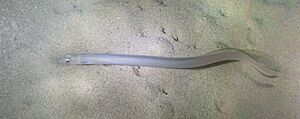Bandtooth conger facts for kids
Quick facts for kids Bandtooth conger |
|
|---|---|
 |
|
| Conservation status | |
| Scientific classification | |
| Synonyms | |
|
The bandtooth conger (Ariosoma balearicum) is a type of eel that lives in the ocean. It's also sometimes called the Baleares conger or the Balearic conger. This interesting fish belongs to the family called Congridae, which includes many different kinds of conger and garden eels.
It was first described by a scientist named François Étienne Delaroche in 1809.
Contents
About the Bandtooth Conger
The bandtooth conger is a marine eel, meaning it lives in saltwater. It prefers warmer, subtropical waters. These eels are known for their long, snake-like bodies.
Where Do They Live?
You can find this eel in many parts of the world! It lives in the western and eastern parts of the Atlantic Ocean and the western Indian Ocean. This includes places like North Carolina in the United States, the northern Gulf of Mexico, parts of South America, Canada, Portugal, Angola, the Mediterranean Sea, and even the Red Sea.
What is Their Habitat Like?
Bandtooth congers like to live near reefs and along the coastlines. They often burrow into soft sand and mud on the seafloor. They can be found at many different depths, from as shallow as 1 meter (about 3 feet) to as deep as 732 meters (about 2,400 feet). However, they are most commonly seen between 20 and 100 meters (about 65 to 330 feet) deep.
How Big Do They Get?
Male bandtooth congers can grow up to 35 centimeters (about 14 inches) long. However, they are more commonly found at about 25 centimeters (about 10 inches) in length.
Are They Important to Fisheries?
The bandtooth conger is not a major target for fishing. It is only of minor interest to fisheries, meaning it's not caught in large numbers for food or other uses.


